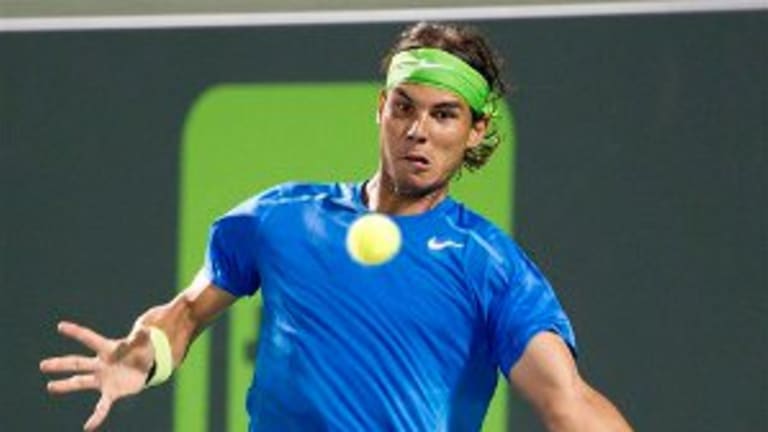A match that began as a comedy of errors ended in much the same fashion, as Rafael Nadal withstood second-set nerves and the haphazard talent that is Jo-Wilfried Tsonga to progress to the semifinals, 6-2, 5-7, 6-4.
I’ve heard that Albert Einstein’s definition of insanity is doing the same thing over and over again and expecting different results. That could also serve as a neat description of Tsonga’s stubborn adherence to the same tactics tonight. He started the match broken from 40-0 up, going for outrageous first-strike winners, coming into net behind sliced backhand approach shots that were fodder for Nadal’s passers, and playing slipshod drop-shots that rarely cleared the net—and were swiftly cleaned up by Rafa when they did. He ended the match nearly three hours later doing precisely the same things.
It takes two to get properly tangled in each other’s tennis, however, and while there is no denying that Tsonga’s performance was woeful for the first set and a half—he racked up 55 unforced errors for the match—much of that had to do with the relentless depth that Nadal kept on his groundstrokes during that period. It forced Tsonga to go for far too much from deep behind the baseline, or risk net approaches, because he knew as well as anyone that a long rally would only end in Nadal’s favor.
As the second set progressed and the wind picked up, Nadal’s level dropped and his shots began to land consistently shorter—an average of one meter shorter than the first set—allowing Tsonga to play from inside the court. Nadal served for the match at 5-4, but played a poor game, and the subsequent break acted as a much-needed fillip to the Frenchman’s confidence. His ripped groundstrokes began to land in, and with Nadal one point from a tiebreak at 5-6, Tsonga hit three great returns, the last a clean winner which stole the set from under Nadal’s nose.
Whether or not Nadal is developing a troubling habit of letting leads slip, he has a much more deeply ingrained habit to fall back on—that of digging deep, battling, and ultimately winning. Attended by the trainer on changeovers for a problem with his left knee, he nevertheless hung grimly on to his serve in the third set, saving a break point at 2-3 and weathering the storm. At 4-4 on Tsonga’s serve, Nadal opened the game with one of his trademark curving forehand passing shots that had been barely in evidence thus far. It proved to be a good omen; he broke serve and served out the match at the second time of asking, rescuing himself from a hole at 15-30 with an astonishing display of agility at net.
Nadal had a stroke of luck when Tsonga broke a string returning a weak second serve on break point, but the final result had little to do with the vagaries of fortune. It was an effort of will and grim determination not to let go of a match which came very close to slipping through his fingers.
